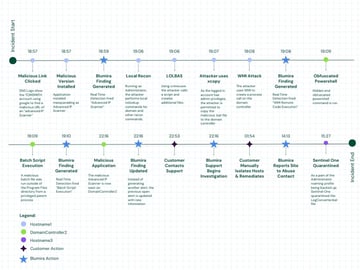Malicious scripts are a key part of every attack and pentest. These malicious scripts are often run in PowerShell (PS) within Windows environments. PowerShell is one of the most powerful tools available used to control a Windows machine from within. One of Blumira’s first recommendations for Windows environments is to only allow necessary users the ability to use PowerShell. The general end user should not have access to PowerShell in any way.
Oftentimes, PowerShell permissions are given to administrators, developers, security practitioners, and sometimes even third-parties that are issued credentials for access to the environment. Allowing these users to have access to PowerShell opens a security gap in your network. It allows for attackers to have an elevated foothold within your network as soon as they’re able to access one of those user accounts, hosts, or sessions.
What is Execution Policy Bypass?
When PowerShell isn’t appropriately locked down, running execution policy bypasses becomes quite easy to do. Windows calls the execution policy less of a safety feature, but more of a suggestion. As we know by now, attackers aren’t looking for domain admin suggestions when actively attempting to traverse through a network. This is where our detection team wanted to help. Although it’s not possible to audit every command user running in PowerShell from the Windows domain admin side, Blumira is able to detect on the scripts and commands using our robust command-line logging.
Here is what a bypass on the PowerShell command line looks like –
PowerShell.exe -ExecutionPolicy Bypass -File .runme.ps1
Just imagine .runme.ps1 gathers all current user information, passwords stored in plaintext, connections to shared drives, etc. This is how easy your execution policy is to bypass.
You may be asking yourself, “Why can’t I just ban the use of “Bypass” in PowerShell?” Unfortunately, you cannot prevent PowerShell from executing scripts, because that’s one of its main purposes. You can, however, set the policy to prevent scripts – or allow only signed scripts, for example, but anyone with access to run PowerShell.exe can use the ‘-ExecutionPolicy’ command line parameter to bypass your policy.
How Does Blumira Help?
Don’t worry though: Blumira has crafted a detection that will give you real-time alerts when ‘Bypass’ is used in your command line. All we need is for you to have command line logging setup with NXlog, one of our primary forms of Windows logging. That way, when you see one of our alerts trigger, you’ll see who was running the command, what command was run, and be able to review a few other helpful details. Your plan of action should be:
- Reach out to the user.
- Correlate the action with that user.
- If no correlation can be found, you should immediately lock the account in question.
- Start to mitigate a possible attack on your network.
Your Guide to Microsoft Security
To help organizations running Microsoft environments, our guide gives you practical, step-by-step Windows tips to significantly improve your visibility into malicious activity.
Nick Brigmon
A Detroit native and graduate of Eastern Michigan University’s outstanding Information Assurance program, Nick has been working full time in IT for over six years. The last five years of his career have been dedicated exclusively to Information Security first as a Security Analyst for NetWork Group’s Managed Detection...
More from the blog
View All PostsSubscribe to email updates
Stay up-to-date on what's happening at this blog and get additional content about the benefits of subscribing.




